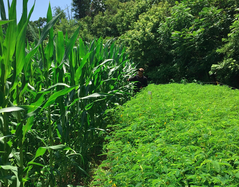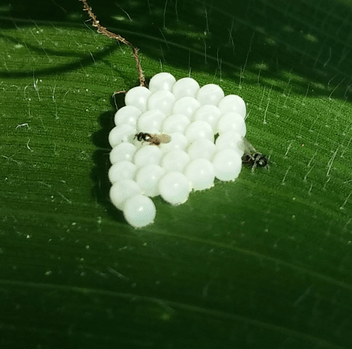 Figure 1. Can field corn (left) benefit from insects attracted by partridge pea (right)? (Photo credit: Lauren Hunt) Figure 1. Can field corn (left) benefit from insects attracted by partridge pea (right)? (Photo credit: Lauren Hunt) Conservation biological control – a fancy term for the support of beneficial insects in a cropping system to enhance natural pest control - has long been of interest in organic agriculture. Lauren Hunt of the Department of Entomology’s Hooks Lab has been investigating the potential for conservation biological control in organic field corn using partridge pea (Chamaecrista fasciculata) to attract and support insects that feed on and parasitize pests. Many predators and parasitoids, collectively called beneficial insects or natural enemies, need nectar resources offered by flowers to successfully develop and reproduce. Partridge pea offers these nectar resources to insects in the form of flowers and via special glands, termed “extrafloral nectaries” located at the base of the petioles. These nectaries are particularly attractive to wasps known to parasitize a variety of insect pests, including stink bugs, corn earworms, and corn borers – common pests of corn and key pests in Lauren’s study.
Results from her two-year study confirmed that partridge pea does in fact support much higher numbers of natural enemies than field corn or naturally occurring grassy vegetation. Unfortunately, this increase did not translate into an increase in natural enemies within the cornfield, or a decrease in pest-related damage. There are several possible reasons why, but the most likely reason is that in this system, biological control – or any form of pest control – was not necessary. Lauren found incredibly low numbers of all species of pests throughout the season. This was most likely due to the area wide suppression of Lepidopteran (moth) pests resulting from the widespread cultivation of Bt corn. Additionally, almost 90% of the stink bug eggs laid in the corn were killed by parasitoid wasps (Fig. 2) or predators, regardless of treatment. Since pest numbers were so low and mortality was so high, detecting differences between treatments is challenging. It is possible that in a system with higher pest pressures, there would have been a benefit of pest control seen in plots surrounded by the insectary partridge pea.
About the Authors: Veronica Johnson is a Master’s student whose research focuses on determining the role of different post-harvest litter management practices in the degradation of Cry proteins in genetically modified Bt corn. She is also looking to determine the effects of winter temperature and precipitation on both tissue decomposition and protein degradation under these various litter management practices. Peter Coffey is a Master's student whose research focuses on using cover crops to optimize sustainable farming economics. His current projects using lima beans and eggplant as model systems focus on plant nutrition, weed suppression, influences on pest and beneficial insects, and crop yield value. Follow him on twitter at @petercoffey. Comments are closed.
|
Categories
All
Archives
June 2024
|
Department of Entomology
University of Maryland
4112 Plant Sciences Building
College Park, MD 20742-4454
USA
Telephone: 301.405.3911
Fax: 301.314.9290
University of Maryland
4112 Plant Sciences Building
College Park, MD 20742-4454
USA
Telephone: 301.405.3911
Fax: 301.314.9290



 RSS Feed
RSS Feed




